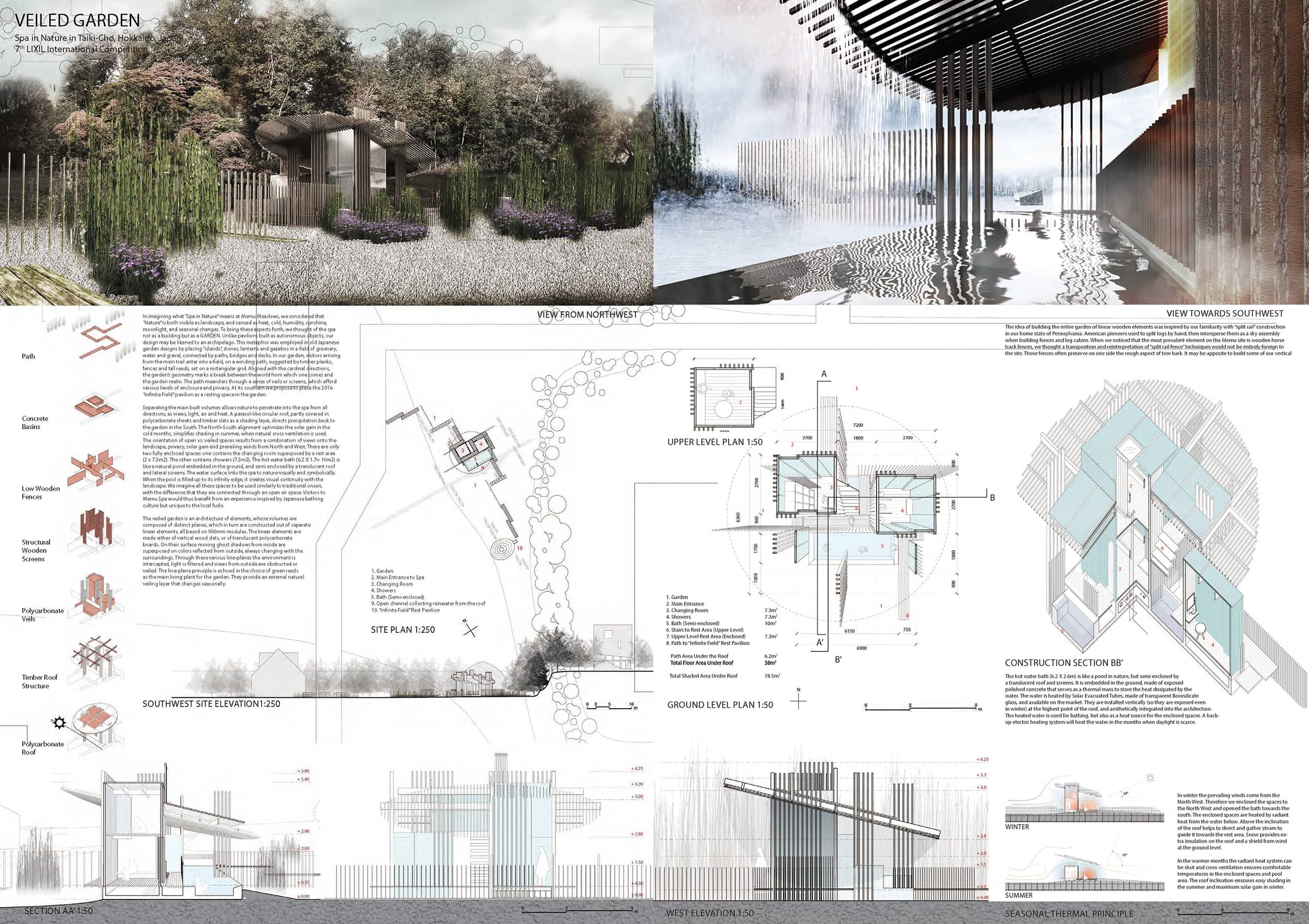LIXIL INTERNATIONAL UNIVERSITY ARCHITECTURAL COMPETITION
“NEXT GENERATION SUSTAINABLE HOUSE IN TAIKI-CHO”
Curator: Kengo Kuma
2017
Spa in the Nature
Author
PDF Composed by Takaharu Igarashi, Memu Earth Lab Researcher 2019.
Original contents belong to LIXIL JS Foundation.
Students from the following universities produced the content.
・University of Pennsylvania (USA), the award of excellence
・University of Buenos Aires (Argentina)
・AA School (UK)
・IAAC (Spain)
・Riga Technical University (Latvia)
・The Vienna Technical University (Austria), the award of excellence
・China Academy of Art (China)
・National Cheng Kung University (Taiwan)
・Universitas Indonesia (Indonesia)
・The University of Sydney (Australia)
・Kyushu University (Japan), the top prize
・Tokyo University of the Arts (Japan)
・Meiji University (Japan)

Abstract
Spa in the Nature
The public baths of ancient Rome, the Great Bath in Pakistan’s Mohenjo-Daro, Germany’s Baden Baden, England’s city of Bath, Finnish saunas or Japanese “onsen” (hot spring) or steam baths going back to a time long before the Middle Ages – there is a variety of bathing customs found throughout the world. Even in earlier times, baths were not merely intended to remove soil and stains. They were also places of social interaction, public areas as relaxing as a living room.
In the rich natural setting of the town of Taiki, Hokkaido, what would a relaxing bath spot be like? One should do more than simply soak. Imagine places to stretch or enjoy a massage, stroll through the lush natural setting, dally away a day, or other kinds of activities. Under a roof or not? Do men and women share spaces? Aren’t there new and untried ways of thinking about a bathing spot and its pleasures? The Royal Danish Academy of Fine Arts winning design for 6th LIXIL International Student Architectural Competition,‘INFINITE FIELD” is a movable pavilion which perhaps might have a place in the spa-like setting you design. Unlike past years, this theme encourages direct contact of architecture on skin. This new approach may also arouse new ways of employing building materials. Please design a spa where visitors can relax and enjoy the expanse of the surrounding grassland.
自然の中のスパ
古代ローマの公衆浴場やモヘンジョダロの大浴場,ドイツのバーデン=バーデン,イギリスのバース,フィンランドのサウナ,日本の温泉や中世以前から多様された蒸し風呂など,世界中にはさまざまなスタイルのお風呂があります.歴史的に見てもお風呂は汚れを落とすだけではなく,社交場として,パブリックスペースとして,リビングのようなくつろぐための場所としての機能も持ち合わせていました.では,この大樹町で自然と共にあり,リラックスできるお風呂とはどのようなものでしょうか.そこではお湯につかるだけではなく,ストレッチやマッサージをしたり,豊かな自然の中を散策したり,ゆっくりとした時間を過ごすなど,いろんなアクティビティが考えられるでしょう.また屋内や外,男女がどのように入るのかということからも,お風呂でできることが新しく考えられるかもしれません.移動可能な建築の第6 回優勝校のデンマーク王立芸術アカデミーによる「INFINITE FIELD」と連動した使い方も考えられるかもしれません.また,今回の課題はこれまでとは違い,肌に直接ふれるものです.そうした使われ方から,新しい素材の使い方も提案できるかもしれません.場所はメムメドウズ内の敷地とします.お湯はこの場で沸かしても,近くの川や海の水を利用したり,温泉から運んできても結構です.人が集い,リラックスできる草原のお風呂を考えてください.
Jury
Kengo Kuma (Architect/Professor, The University of Tokyo)
Tomonari Yashiro (Professor, Institute of Industrial Science, The University of Tokyo)
Kundo Koyama (Television, radio, and scriptwriter)
Dana Buntrock (Architect/Professor, Department of Architecture, University of California, Berkeley)
Yoshiharu Tsukamoto (Architect//Professor, Graduate School of Architecture and Building Engineering, Tokyo Institute of Technology)
Related Articles
–
2016
Comfort of Lightness
Author
PDF Composed by Takaharu Igarashi, Memu Earth Lab Researcher 2019.
Original contents belong to LIXIL JS Foundation.
Students from the following universities produced the content.
・Chulalongkorn University (Thailand)
・Cornell University (USA)
・HESAM University / École Nationale Supérieure d’Architecture de Paris-La Villette (France), the award of excellence
・Kyoto Institute of Technology (Japan)
・Parsons School of Design (USA)
・Politecnico di Milano (Italy), the award of excellence
・The Royal Danish Academy of Fine Arts, Schoools of Architecture, Design and Conservation (Denmark), the top prize
・Swiss Federal Institute of Technology (ETH) Zurich (Switzerland)
・Universidad Nacional Autónoma de México (Mexico)
・University of Cape Town (South Africa)
・The University of Melbourne (Australia)
・Yokohama National University (Japan), the award of excellence
Abstract
ライトウェイトな快適さ
現代の快適さは,環境を遮断し,バリアをつくることによりもたらされてきました.しかし,現代に必要なものは,自然に近い暮らしなのかもしれません.そこで快適な生活を楽しむことのできる,組み立て,移動できる軽い住居を考えてください.移動できるということは,周囲の状況を読み取り,配慮し,関係を持つということです.また簡易な組み立て住居であることは,自然の環境や地面に近づき,その場所の豊かさをもたらすでしょう.組み立て,移動でき,大樹町の夏や冬など,環境を楽しめる住居を考えてください.ここで考える自然や周囲との関係は,都市に移動しても可能な周囲の読み取り方をもたらすかもしれません.最優秀案は実施を前提とします.また,複数の棟をつくる場合や既存施設との関係も想定し,配置も考慮してください.大樹町でどのような作業をするのか,また組み立て方を含めたつくり方も提案してください.ただし,必要な設備は既存の施設を利用します
Jury
Kengo Kuma (Architect/Professor, The University of Tokyo)
Tomonari Yashiro (Professor, Institute of Industrial Science, The University of Tokyo)
Masato Araya (Structural Engineer, Professor Emeritus, Waseda University)
Dana Buntrock (Architect/Professor, Department of Architecture, University of California, Berkeley)
Yoshiharu Tsukamoto (Architect//Professor, Graduate School of Architecture and Building Engineering, Tokyo Institute of Technology)
Related Articles
–
